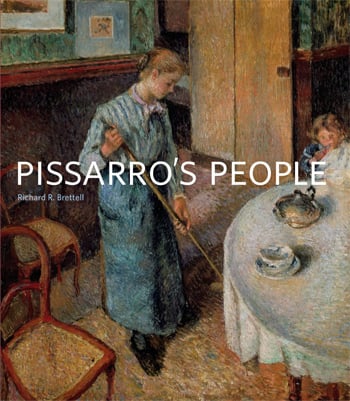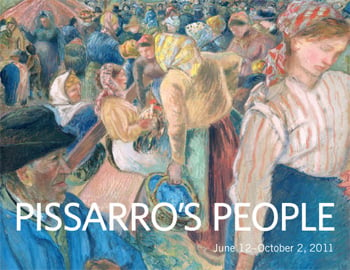
JUNE 12–OCTOBER 2, 2011
ABOUT the artist
Often regarded as the “father” of the Impressionist movement, Camille Pissarro (1830–1903) was born into a Jewish family of French, originally Portuguese, descent. His parents Frédéric Pissarro and Rachel Petit (née Manzana Pomié) ran a small business in general merchandise on the Caribbean island of Saint Thomas (then a Danish dependency), where Camille was born. Pissarro never revoked this Danish citizenship, despite spending nearly his entire adult life in France.
Pissarro’s artistic inclinations first surfaced when he was a schoolboy at Passy, near Paris, from 1842 to 1847, but he was essentially self-taught. His acquaintance around 1850 with a Danish artist, Fritz Melbye, convinced him of his true vocation and also provided him with some academic instruction. Between 1852 and 1854 they traveled together to Venezuela and established a studio in Caracas. During these early years, Pissarro studied nature under tropical conditions (in particular the effects of natural light) and closely observed peasant life.
Pissarro returned to France in early October 1855 to advance his artistic career. His arrival in Paris coincided with the Exposition Universelle, which provided him with an immediate opportunity to broaden his artistic horizons. In Paris he attended private classes at the École des Beaux-Arts in 1856, and in 1861 he registered as a copyist in the Musée du Louvre. At the Académie Suisse, which he attended from about 1859, he met Paul Cézanne and Claude Monet and his first submissions to the Salon date from this time. His works were accepted for exhibition almost every year until 1870. Although he kept a studio in Paris, Pissarro preferred to live in more rural places, such as Montmorency, La Roche-Guyon, Varenne-Saint-Maur, Louveciennes and Pontoise. Around 1860 Pissarro formed a liaison with Julie Vellay, a vine-grower’s daughter from Burgundy who worked for the Pissarro family. They had eight children between the years 1863 and 1884 and were married in London in 1871.
Pissarro’s works from the first half of the 1870s are notable for their firmly controlled compositions, lighter brushwork, and use of a brighter palette applied in separate patches of unmixed pigments. Pissarro’s aim in such works was to record as accurately as possible on the canvas the sensations he experienced in nature, and his various stylistic changes attest to his willingness to experiment with different approaches. Of greatest significance at this time was Pissarro’s friendship with Cézanne; they often worked together, sometimes painting the same subjects and frequently re-examining motifs first painted by Pissarro in the late 1860s. In their search for a new sense of space they began to regulate their brushstrokes and restrict the color range of their palettes.
Between 1874 and 1886, Pissarro participated in—and helped organize—exhibitions of the Impressionists. This group of independent artists, which included Renoir, Monet, and Degas, had banded together in Paris in the 1870s, bound by their defiant attitude towards conventional artistic practice. Pissarro was among the most experimental, deliberate, and dedicated of his cohort, and he was the only artist to participate in all eight Impressionist exhibitions.
Pissarro reached a stylistic crisis at the end of the 1870s as he endeavored to record the appearance of nature with a myriad of smaller, comma-like brushstrokes built up in layers on the surface of the canvas. Ultimately Pissarro felt that such compositions lacked clarity, and again he sought to give a new emphasis to his work, this time in collaboration with Degas. For a time they worked together making prints. Pissarro began to devise more complex compositions, including crowded market scenes with greater numbers of figures. He moved away from Pontoise in 1882 to the small neighboring village of Osny and two years later to the village of Éragny-sur-Epte in Normandy. Pissarro was introduced to Paul Signac and Georges Seurat in 1885, and in the years that followed he began to work in the pointillist style adopted by the Neo-Impressionists, aligning himself with the avant-garde and identifying himself with a younger generation of artists, including van Gogh. Few of his pictures can be strictly defined as pointillist, however, and in the last decade of his life, Pissarro returned to a purer Impressionist style, which he achieved with greater technical ability, renewed confidence in his compositions, and freer brushwork. In the years 1890 to 1903, he struck a balance between urban and rural subject-matter; limited his exploration of rural themes mainly to areas around Éragny-sur-Epte, and for the first time included depictions of the female nude.
Pissarro’s choice of themes in much of his work reflects his political thinking. His commitment to the human figure, particularly the rural workers of the countryside around Paris, is unique among the Impressionist landscape painters, and he was consistently interested in the notion of labor as it related to agricultural and artistic practice alike. A committed supporter of anarchism, he was friendly with the leading representatives of the movement in France, such as Jean Grave and Élisée Reclus, and was well-versed in anarchist literature. His concern for contemporary issues is illustrated in the series of lithographs he made for Grave’s anarchist journal Les temps nouveaux, and, more privately, in Turpitudes sociales, a series of drawings he made for his nieces to educate them in the horrors of modern capitalist society.
Despite suffering from the eye condition dacryocystitis, Pissarro remained active to the very end of his life, frequently travelling to England to visit his eldest son, Lucien, and spending a short period of self-enforced political exile in Belgium in 1894. By the end of his life, his work was beginning to sell well, not only in France, but also in Germany and the United States. Pissarro died in 1903 and is buried in the Père Lachaise Cemetery in Paris.

Click to download the exhibition brochure (PDF) from Pissarro's People.

Richly illustrated with more than 200 paintings, works on paper, and archival images, this compelling volume offers a definitive portrait of one of the most passionately political painters of the nineteenth century.

